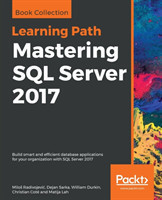Leverage the power of SQL Server 2017 Integration Services to build data integration solutions with ease
Key Features
- Work with temporal tables to access information stored in a table at any time
- Get familiar with the latest features in SQL Server 2017 Integration Services
- Program and extend your packages to enhance their functionality
Book Description
Microsoft SQL Server 2017 uses the power of R and Python for machine learning and containerization-based deployment on Windows and Linux. By learning how to use the features of SQL Server 2017 effectively, you can build scalable apps and easily perform data integration and transformation.
You’ll start by brushing up on the features of SQL Server 2017. This Learning Path will then demonstrate how you can use Query Store, columnstore indexes, and In-Memory OLTP in your apps. You'll also learn to integrate Python code in SQL Server and graph database implementations for development and testing. Next, you'll get up to speed with designing and building SQL Server Integration Services (SSIS) data warehouse packages using SQL server data tools. Toward the concluding chapters, you’ll discover how to develop SSIS packages designed to maintain a data warehouse using the data flow and other control flow tasks.
By the end of this Learning Path, you'll be equipped with the skills you need to design efficient, high-performance database applications with confidence.
This Learning Path includes content from the following Packt books:
- SQL Server 2017 Developer's Guide by Miloš Radivojević, Dejan Sarka, et. al
- SQL Server 2017 Integration Services Cookbook by Christian Cote, Dejan Sarka, et. al
What you will learn
- Use columnstore indexes to make storage and performance improvements
- Extend database design solutions using temporal tables
- Exchange JSON data between applications and SQL Server
- Migrate historical data to Microsoft Azure by using Stretch Database
- Design the architecture of a modern Extract, Transform, and Load (ETL) solution
- Implement ETL solutions using Integration Services for both on-premise and Azure data
Who this book is for
This Learning Path is for database developers and solution architects looking to develop ETL solutions with SSIS, and explore the new features in SSIS 2017. Advanced analysis practitioners, business intelligence developers, and database consultants dealing with performance tuning will also find this book useful. Basic understanding of database concepts and T-SQL is required to get the best out of this Learning Path.

















